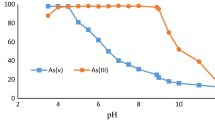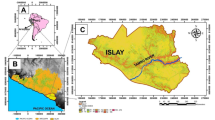Abstract
Spinel ferrite particles (Fe3O4, MnFe2O4, and CoFe2O4) were investigated as magnetic nanosorbents for removing arsenic from spiked water samples. The nanosorbents were collected via magnetic separation from aqueous solutions spiked with an arsenic concentration that mimics the amount of this contaminant in real water samples. This research shows that using amounts of CoFe2O4 or MnFe2O4 as low as 40 mg/L, the arsenic content in the contaminated water decreased for levels below the maximum admitted value by the World Health Organization for drinking waters (10 μg/L). Moreover, these magnetic nanosorbents also showed good performance for As(V) sorption, when applied to aqueous matrices with variable ionic strength and in the mixtures of other several hazardous contaminants. The good performance observed for the MnFe2O4 and CoFe2O4 ferrites contrasts with the one observed for Fe3O4 nanosorbent, whose efficiency is lower in the removal of As(V) from water, nevertheless increased with the presence of other elements in solution.








Similar content being viewed by others
References
Aksu Z, Kabasakal E (2004) Batch adsorption of 2,4-dichlorophenoxy-acetic acid (2,4-D) from aqueous solution by granular activated carbon. Sep Purif Technol 35:223–240
Alqadami AA, Naushad M, Abdalla MA et al (2017) Efficient removal of toxic metal ions from wastewater using a recyclable nanocomposite: a study of adsorption parameters and interaction mechanism. J Clean Prod 156:426–436
Ambashta RD, Sillanpää M (2010) Water purification using magnetic assistance: a review. J Hazard Mater 180:38–49
Bellusci M, La Barbera A, Seralessandri L et al (2009) Preparation of albumin-ferrite superparamagnetic nanoparticles using reverse micelles. Polym Int 58:1142–1147
Bhatnagar A, Vilar VJP, Botelho CMS, Boaventura RAR (2010) Coconut-based biosorbents for water treatment—a review of the recent literature. Adv Colloid Interf Sci 160:1–15
Chitu L, Jergel M, Majkova E et al (2007) Structure and magnetic properties of CoFe2O4 and Fe3O4 nanoparticles. Mater Sci Eng C 27:1415–1417
Darezereshki E, Darban-Khodadadi A, Abdollahy M, Jamshidi-Zanjani A (2018) Influence of heavy metals on the adsorption of arsenate by magnetite nanoparticles: kinetics and thermodynamic. Environ Nanotechnol Monit Manag 10:51–62
Davidescu CM, Dumitru R, Negrea A et al (2015) Arsenic removal through adsorption on cobalt nanoferrite. Rev Chem 66:1742–1746
Environmental Protection Agency (2000) Arsenic occurrence in public drinking water supplies. EPA, Washington DC
European Parliament C (1998) Diário da República-I SÉRIE-A (1998) Decreto-Lei n.o. 236/98. In: DR 176/98 SÉRIE I-A de 1998-08-01, p 47
European Parliament C (2007) Diário da Repúbica-I SÉRIE-A (2007) Decreto-Lei n.o. 306/07. In: DR 164/07 SÉRIE I-A de 2007-08-27, p 19
Garelick H, Jones H, Dybowska A, Valsami-Jones E (2008) Arsenic pollution sources. Rev Environ Contam Toxicol 197:17–60
Girginova PI, Daniel-da-Silva AL, Lopes CB, Figueira P, Otero M, Amaral VS, Pereira E, Trindade T (2010) Silica coated magnetite particles for magnetic removal of Hg2+ from water. J Colloid Interface Sci 345:234–240
Hamadi NK, Swaminathan S, Chen XD (2004) Adsorption of Paraquat dichloride from aqueous solution by activated carbon derived from used tires. J Hazard Mater 112:133–141
Ho YS, McKay G (1999) Pseudo-second order model for sorption processes. Process Biochem 34:451–465
Höll WH (2010) Mechanisms of arsenic removal from water. Environ Geochem Health 32:287–290
Huang W, Wang S, Zhu Z, Li L, Yao X, Rudolph V, Haghseresht F (2008) Phosphate removal from wastewater using red mud. J Hazard Mater 158:35–42
Inglezakis VJ, Fyrillas MM, Park J (2019) Variable diffusivity homogeneous surface diffusion model and analysis of merits and fallacies of simplified adsorption kinetics equations. J Hazard Mater 367:224–245
Jia Y, Xu L, Fang Z, Demopoulos GP (2006) Observation of surface precipitation of arsenate on ferrihydrite. Environ Sci Technol 40:3248–3253
Kalska-Szostko B, Wykowska U, Piekut K, Satuła D (2014) Stability of Fe3O4 nanoparticles in various model solutions. Colloids Surf A Physicochem Eng Asp 450:15–24
Kefeni KK, Mamba BB, Msagati TAM (2017) Application of spinel ferrite nanoparticles in water and wastewater treatment: a review. Sep Purif Techol 188:399–422
Kim J, Benjamin MM (2004) Modeling a novel ion exchange process for arsenic and nitrate removal. Water Res 38:2053–2062
Lagergren S (1898) Zur theorie der sogenannten adsorption geloster stoffe, Kungliga Svenska Vetenskapsakademiens. Handlingar 24:1–39
Lata S, Samadder SR (2016) Removal of arsenic from water using nano adsorbents and challenges: a review. J Environ Manag 166:387–406
Leal E, Dantas J, dos Santos PTA et al (2018) Effect of the surface treatment on the structural, morphological, magnetic and biological properties of MFe2O4 iron spinels (M=Cu, Ni, Co, Mn and Fe). Appl Surf Sci 455:635–645
Low MJD (1960) Kinetics of chemisorption of gases on solids. Chem Rev 60:267–312
Margabandhu M, Sendhilnathan S, Senthilkumar S, Gajalakshmi D (2016) Investigation of structural, morphological, magnetic properties and biomedical applications of Cu2+ substituted uncoated cobalt ferrite nanoparticles. Brazilian Arch Biol Technol 59:1–10
Martinez-Vargas S, Martínez AI, Hernández-Beteta EE et al (2018) As(III) and As(V) adsorption on manganese ferrite nanoparticles. J Mol Struct 1154:524–534
Matlock MM, Howerton BS, Atwood DA (2002) Chemical precipitation of heavy metals from acid mine drainage. Water Res 36:4757–4764
Mehran E, Shayesteh SF, Sheykhan M (2016) Structural and magnetic properties of turmeric functionalized CoFe2O4 nanocomposite powder. Chin Phys B 25:107504
Mohan D, Pittman CU (2007) Arsenic removal from water/wastewater using adsorbents—a critical review. J Hazard Mater 142:1–53
Monterroso P, Abreu SN, Pereira E et al (2003) Estimation of Cu, Cd and Hg transported by plankton from a contaminated area (Ria de Aveiro). Acta Oecol Int J Ecol 24:S351–S357
Moradian M (2013) A new and efficient method for the adsorption and separation of arsenic metal ion from mining waste waters of zarshouran gold mine by magnetic solid-phase extraction with modified magnetic nanoparticles. Int J Nanosci Nanotechnol 9:121–126
Nasiri R, Arsalani N, Panahian Y (2018) One-pot synthesis of novel magnetic three-dimensional graphene/chitosan/nickel ferrite nanocomposite for lead ions removal from aqueous solution: RSM modelling design. J Clean Prod 201:507–515
Nordstrom DK, Majzlan J, Koenigsberger E (2014) Thermodynamic properties for arsenic minerals and aqueous species. Rev Mineral Geochem 79:217–255
Oliveira-Silva R, da Costa JP, Vitorino R, Daniel-da-Silva AL (2015) Magnetic chelating nanoprobes for enrichment and selective recovery of metalloproteases from human saliva. J Mater Chem B 3:238–249
Parsons JG, Lopez ML, Peralta-Videa JR, Gardea-Torresdey JL (2009) Determination of arsenic(III) and arsenic(V) binding to microwave assisted hydrothermal synthetically prepared Fe3O4, Mn3O4, and MnFe2O4 nanoadsorbents. Microchem J 91:100–106
Qiu H, Lv L, Pan B et al (2009) Critical review in adsorption kinetic models. J Zhejiang Univ A10:716–724
Ramana C V, Kolekar YD, Bharathi KK et al (2013) Correlation between structural, magnetic, and dielectric properties of manganese substituted cobalt ferrite. J Appl Phys 114:1–9
Ricci Nicomel N, Leus K, Folens K et al (2016) Technologies for arsenic removal from water: current status and future perspectives. Int J Environ Res Public Health 13:1–24
Saiz J, Bringas E, Ortiz I (2014) Functionalized magnetic nanoparticles as new adsorption materials for arsenic removal from polluted waters. J Chem Technol Biotechnol 89:909–918
Sun S, Zeng H, Robinson D, Raoux S, Rice PM, Wang SX, Li G (2004) Monodisperse MFe2O4 (M=Fe, Co, Mn) nanoparticles. J Am Chem Soc 126:273–279
Tang SCN, Lo IMC (2013) Magnetic nanoparticles: Essential factors for sustainable environmental applications. Water Res 47:2613–2632
Tavares DS, Lopes CB, Coelho JP et al (2012) Removal of arsenic from aqueous solutions by sorption onto sewage sludge-based sorbent. Water Air Soil Pollut 223:2311–2321
Tavares DS, Daniel-da-Silva AL, Lopes CB et al (2013) Efficient sorbents based on magnetite coated with siliceous hybrid shells for removal of mercury ions. J Mater Chem A 1:8134–8143
Wang W, Ding Z, Zhao X, et al (2015) Microstructure and magnetic properties of MFe2O4 (M=Co, Ni, and Mn) ferrite nanocrystals prepared using colloid mill and hydrothermal method. J Appl Phys 117:1–4
Yang J-C, Yin X-B (2017) CoFe2O4@MIL-100(Fe) hybrid magnetic nanoparticles exhibit fast and selective adsorption of arsenic with high adsorption capacity. Sci Rep 7:40955
Zhang S, Niu H, Cai Y et al (2010) Arsenite and arsenate adsorption on coprecipitated bimetal oxide magnetic nanomaterials: MnFe2O4 and CoFe2O4. Chem Eng J 158:599–607
Acknowledgements
This work was developed within the scope of the project CICECO-Aveiro Institute of Materials (UIDB/50011/2020 & UIDP/50011/2020), CESAM (UID/AMB/50017), and CIIMAR (UID/Multi/04423/2013) financed by national funds through the FCT/MCTES and when appropriate co-financed by FEDER under the PT2020 Partnership Agreement. Daniela S. Tavares thanks the funds through the Portuguese Science Foundation (FCT) for the doctoral grant (SFRH/BD//103828/2014), and Cláudia B. Lopes acknowledges the costs resulting from the FCT hirings funded by national funds (OE), through FCT, I.P., in the scope of the framework contract foreseen in the numbers 4, 5, and 6 of the article 23, of the Decree-Law 57/2016, of August 29, changed by Law 57/2017, of July 19.
Author information
Authors and Affiliations
Corresponding author
Additional information
Responsible Editor: Tito Roberto Cadaval Jr
Publisher’s note
Springer Nature remains neutral with regard to jurisdictional claims in published maps and institutional affiliations.
Rights and permissions
About this article
Cite this article
Tavares, D.S., Lopes, C.B., Almeida, J.C. et al. Spinel-type ferrite nanoparticles for removal of arsenic(V) from water. Environ Sci Pollut Res 27, 22523–22534 (2020). https://doi.org/10.1007/s11356-020-08673-9
Received:
Accepted:
Published:
Issue Date:
DOI: https://doi.org/10.1007/s11356-020-08673-9




